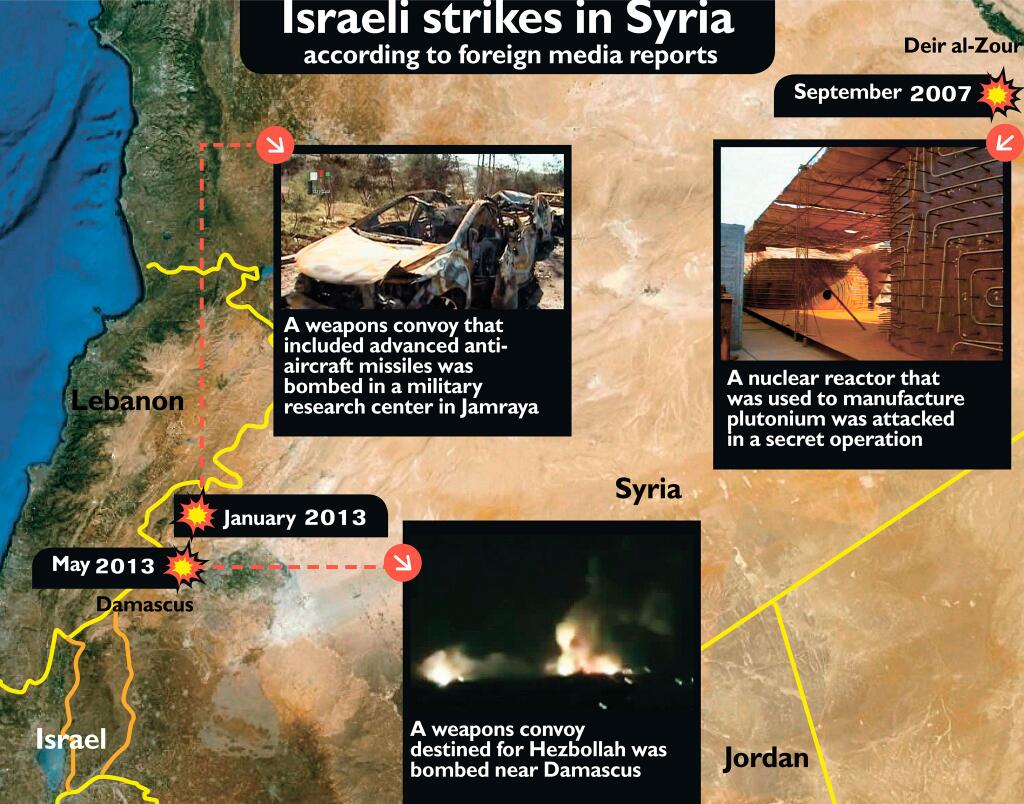Israel bombs Syria — what we know and don’t know
For the details at the start of the bombing, take a look at last night’s post, Reports – large explosions in Damascus (Update – Syria blames Israel), which has embedded videos and Twitter accounts. The Twitter feed now is at the bottom of this post.
This morning various news reports confirm that there were several sites attacked, and there is little doubt that Israel was behind the attacks. But as usual, the precise details remain sketchy.
Visit NBCNews.com for breaking news, world news, and news about the economy
The Times of Israel summarizes various news reports:
An unnamed Israeli official told AFP the target was a shipment of Iranian made Fatah-110 missiles that were on their way from Syria to Hezbollah terrorists….A Syrian activist group, the Britain-based Syrian Observatory for Human Rights, also reported large explosions in the area of Jamraya. It was not clear if this report, and various other reports of several more explosions in the area, were part of the same Israeli strike, or part of the ongoing civil war in Syria between regime and rebel forces.Other activists, for instance, reported that a blast that hit an ammunition depot in the Qassiyoun mountains near the city. According to a Syrian official who spoke to Al Arabiya, the Syrian regime uses its bases on the mountain to fire missiles at rebel targets in Damascus.“The mountain is a very strategic site that oversees all of Damascus,” said the source. “There is a heavy presence of the Assad forces in the mountain because they are always on-call to launch any possible attack towards the people of the city.”Reuters quoted activists who said they saw jets in the sky over Damascus and that a missile brigade and troop battalions loyal to Assad had been hit.
Claims last night by Hezbollah’s al-Manar television that an Israeli jet was downed appear to have been false.
There have been few reports of casualties. Perhaps that’s because those killed may have been Hezbollah or Iranian troops, something Assad would not want to highlight. One of the sites attacks reportedly was staffed by Iranian Revolutionary Guards.
It is unclear whether Syria will respond, notwithstanding a Syrian official declaring the attack a declaration of war.
Syria has a history of not retaliating for the obvious reason that Israel seems to be able to penetrate Syrian airspace with impunity. One analyst terms the Syrian air defenses a paper tiger. Notably, the Syrian Air Force was nowhere to be found, because it would have been destroyed in short order had it confronted Israeli planes.
Haaretz provides a map of Israeli strikes on Syria in the last several years:
As a precaution, Israel has activated two Iron Dome missile defense systems in northern Israel.
Ynet provides a description of the missiles likely used by Israel, the Spice 2000 and Popeye, and the Fatah 110 Iranian missile whose transfer to Hezbollah sparked the raids:
Spice-2000: Autonomous operations, visual targetingAn autonomous missile, the Spice can be pre-programmed with a photograph of its target, and knows to hone itself in on it. The Spice is known for its destructive capabilities, its ability to perform accurately under any weather conditions, and its ability to remain neutral to attempts at disruption or deception by the enemy…The missile has another benefit, in the form of a reduced radar signature. While the Popeye has a rocket motor which burns fuel and makes it detectable, the Spice glides toward its target using wings.Popeye: Sends video to operatorThe Popeye is considered one of the big development successes of Israel’s military industry. Since its development in the 1970s and its introduction to the Air Force in 1985, it has been sold to foreign militaries including the US, India, Turkey, South Korea and Australia….The missile head carries a television camera, allowing for it to be directed by its operator and locked onto its target, even after launching from the plane. Additionally, the Popeye’s internal navigation system leads it directly to its target.Fateh 110: Precise, deadly, reaches Tel AvivA shipment of Fateh 110 missiles manufactured by Iran and meant for the Hezbollah was the target of the Israeli Air Force in an attack on Damascus International Airport on Friday, and a later attack at a military research facility north of the capital city, said Western intelligence sources Sunday morning, following the second strike.The Fateh 110 is manufactured by Iran, and first came to view in 2001. The initial version was operational at a distance of 170 km, carrying a head of 250 kg of explosives….Hezbollah members were reported to have visited Iran to train in the maintenance and launch of Fateh missiles, before returning to Lebanon. According to reports, the Hezbollah also received copies of the Fateh missile, manufactured in Syria under the sponsorship of Iran. The Syrian version of the Fateh 110, known as the M-600, is considered to be the most evident threat to the Israeli home front.It is likely that the recent shipments of arms to Syria was of this version of the missile, which possess high accuracy at up to 100 meters or less of a target.
Tweets from @LegInsurrection/syria
CLICK HERE FOR FULL VERSION OF THIS STORY
